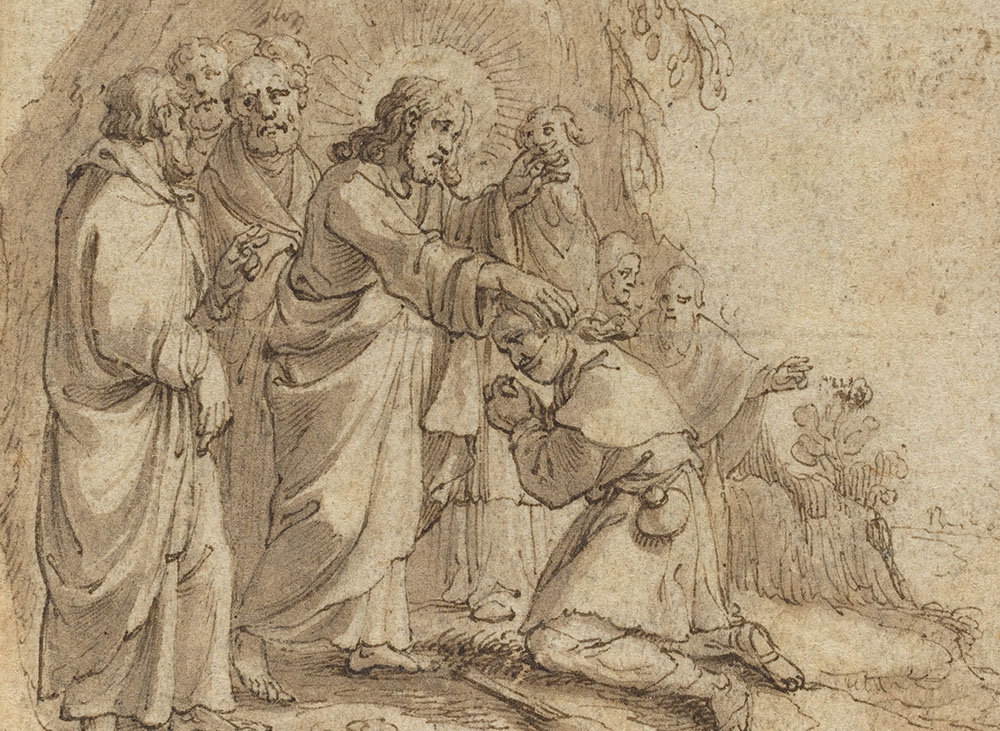
"Christ Healing the Leper," attributed to Flemish artist Pieter de Jode I (1570-1634) (National Gallery of Art)
Mark tells us that Jesus' first healing miracle happened when his touch made it possible for an ailing elder to begin to minister. Quickly thereafter, everybody in Jesus' adopted hometown of Capernaum sought his powerful help.
This was the ideal moment for the local hero to gather an adoring crowd. When sudden popularity propelled Jesus to go away to pray and his disciples tried to bring him back, he called them to follow him into a mission bigger than they could imagine.
If ever Jesus had wanted to demonstrate that popularity was not his goal, touching a leper did the trick. We hear this story and remember unusual saints like Francis of Assisi and Mother Teresa who performed similar actions in their day. But Jesus' compassion and healing power are only the most obvious dimensions of the story.
To understand this incident in context, we might remember that many of Jesus' contemporaries held to an implicit theology of reward and punishment, believing that the universe operates on a law of karma that rewards good and punishes evil. That belief can be quite pleasing to the prosperous — "blessed people" can take credit for their own good health, their affluence and other varieties of privilege or good luck.
The assumption that logically flows from this dogma is that people with social deficits (think of poverty, sickness, intellectual disability, a denigrated class background, skin color, sex or gender identity) are responsible for the disfavor society accords them. Crudely put, it becomes a way for the well-off to say, "I'm OK, you're trash."
Jesus refused to be trapped in that narrow norm. When the leper approached him, Jesus responded with a respect that simultaneously acknowledged the man's dignity and critiqued society's exclusivism. Jesus did not just heal the man, but he showed how an alternative social system operates. Jesus' touch was a sacrament of healing, a sign of communion and a declaration that this man was fully capable of giving witness to God's activity in the world.
When Jesus sent the man to the priest, he was doubling down on his entire Gospel message. On the level of religious formality, Jesus demonstrated respect for the priest, the religious authority that could declare that the man was healthy and could participate in society. Under Jesus' orders, the man invited the priest to do his job of building community.
On a deeper level, Jesus commissioned the man as an evangelist, someone whose very appearance both proclaimed the presence of the reign of God and denounced the exclusivist practices that privilege some at the expense of others. Jesus' order that the man go to the priest before telling anyone else functioned as an invitation to the leaders; they could be among the first to witness what God was doing through him.
If we want to explore what this incident tells us, we might ask what Jesus' novice disciples might have thought at this point. Things seemed to have started off wonderfully as they left their nets behind to watch Jesus overcome the devil and heal the sick. They were probably OK with following him around the area — especially in light of the way his fame reflected on them.
Advertisement
But then things got dicey. What did it say about them when their master touched lepers? Then, why did the guy who had only known Jesus for a minute get sent as the harbinger of the good news? Hadn't they paid their dues by leaving their beds and boats? Shouldn't they at least be sent to accompany the fellow to be sure he got the theology straight?
Jesus saw things differently. From Jesus' perspective, the healed man's lack of knowledge and experience qualified him above disciples who thought they already understood Jesus. Like the formerly blind man of John 9, this man's testimony could be nothing but simple: "I was outcast and diseased and he touched me and made me whole."
Jesus sent the healed man to evangelize religious officialdom. In so doing, Jesus gave his followers their first lesson about the humility necessary for discipleship. Jesus touched the man, healed him and commissioned him to proclaim, "God has done wondrous things for me, from this day forth, all generations will call me blessed."
The messenger became the message. The healed man's good news was that God wants no one marginalized. His grace was that his Gospel came from an experience of salvation that leaves theology speechless. His strength and courage would forever spring from knowing that he was loved and accepted and that no one and nothing could ever take that away.
Mark's first stories of healing demonstrate that a disciple's evangelizing message must spring from encountering Christ's compassion. The messengers themselves become the message insofar as they serve humbly and proclaim God's unlimited love.
[St. Joseph Sr. Mary M. McGlone serves on the congregational leadership team of the Sisters of St. Joseph of Carondelet.]
